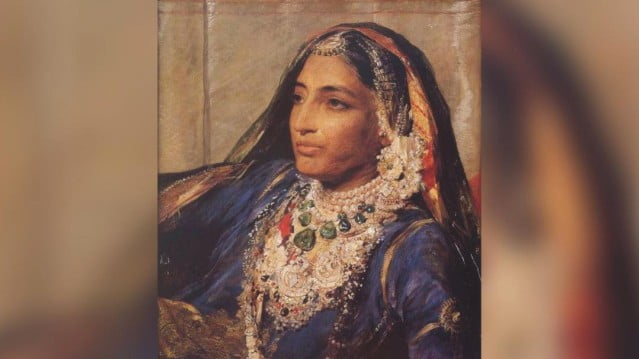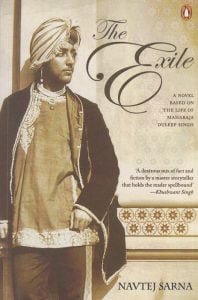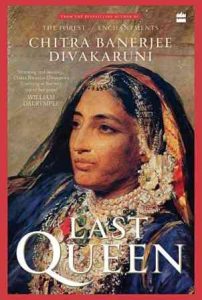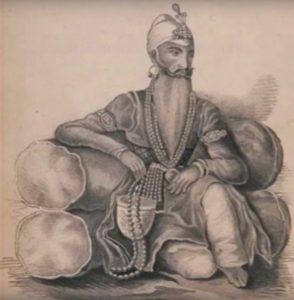

SOMEONE said that history can never be factual. It can merely be closer to or distant from facts. But that said events of significance do leave an imprint on our minds. A repetitive reading of history from varied sources aids us to memorise those events firmly and also make us firmly opinionated about the turn of events.
 In this context the genre of ‘historical fiction’ has its own role to play. Fiction woven around historical happenings aids us to memorise those events minutely and also form an intensive critique of those events.
In this context the genre of ‘historical fiction’ has its own role to play. Fiction woven around historical happenings aids us to memorise those events minutely and also form an intensive critique of those events.
The last book of this genre that I had read a couple of years ago was author Navtej Sarna’s ‘The Exile‘, a fictional biography of last king of kingdom of Lahore Maharaja Dalip Singh.
The fictional account of maharajas life in Sarna’s lilting prose made for an exhilarating read.
Now a book of similar genre titled ‘The Last Queen’ centred around the same epochal times has done a fairly good job and is getting rave reviews.
Author Chitra Banerjee Divakaruni who had earlier won accolades for her work ‘The Forest Of Enchantments‘ (which I also intend to read) also deserves similar accolades for this one. That she is a Bengali was never an impediment for her in the portrayal of Punjabi imagery and Sikh ethos.
 The events pertaining to the formation of sovereign Sikh state and its fall have been very dextrously dealt by the Cunningham, Khushwant Singh, Patwant Singh and so many others of their ilk in their respective scholarly works.
The events pertaining to the formation of sovereign Sikh state and its fall have been very dextrously dealt by the Cunningham, Khushwant Singh, Patwant Singh and so many others of their ilk in their respective scholarly works.
But these scholarly works should be celebrated independently and in no way be allowed to eclipse the glorious works of historical fiction woven around similar events.
The valour associated with the formation of sovereign Sikh state and the elements of Shakespearen tragedy associated with its fall propels different authors to repetitively weave their independent narrative (both fictional and non fictional) around them.
It is for sure that posterity will continue to read and write about these events with similar dramatis personae with even more elan.
The protagonist of Divakaruni’s latest work is Rani Jindan who has been referred to as the the last queen in the title.
Jindan’s meteoric rise from her humble beginnings as a daughter of Manna Singh Aulakh, a kennel keeper of Mahraja Ranjit Singh to his ‘last queen’ have been exquisitely narrated.
It is soon evident that subsequent to her initial dreamy adolescent courting with the not so good looking but the ultra charismatic figure of Maharaja Ranjit Singh, the protagonist has landed in a proverbial gilded cage where initially she is a victim of the machinations of the zenana lead by the seniormost Maharani Mai Nakkain, then to the intrigues of opportunist and avaricious nobles and finally to Machiavellian moves of the British.

Her through and through admiration of the Maharaja Ranjit Singh and yet her paradoxical romantic interlude with Lal Singh,who subsequently proves to be one of the greatest traitors of Sikh history post Maharaja Ranjit Singh’s demise depicts quite a realistic persona of her and not a larger than life haloed figure.
Yet the events when she escapes from British incarceration and walks through treacherous paths and is finally able to find refuge with the Nepal royalty depict her as a gritty woman with fine diplomatic abilities.
By the end of the book she wins admiration with her motherly qualities by instilling pride of his glorious ancestry, religion and patriotism in her methodologically anglicised son Maharaja Dalip Singh who eventually makes futile attempts regain his lost glory.
I would reiterate that the protagonist’s depiction by the author is realistic with all her failings and consequently fetches her admiration.
The events post Maharaja Ranjit Singh’s demise in 1839 to the annexation of Punjab in 1849 moved at a meteoric pace. A lay reader like me often finds impossible to firmly grasp the turn of events in the melee of the death of three crowned rulers and chaotic two Anglo Sikh Wars.
Also Read: Are you ready to count the corpses of Panjab?
Also through the turn of events the loyalty and alignment of leading nobles of the court is in a continuous flux as per their personal suitabilities.
In the midst of this chaos the only force whose efforts are working with clinical precision and eventually fetch results for them are the British and we see the prophecy of ‘Sab lal ho jayega ‘ uttered by the lion of Punjab coming true.

In the context of such lightning turn of events, such works of historical fiction as of Divakaruni’s aid our otherwise limited faculties to grasp the turn of events in their own unimitable manner.
Comparisons are odious. But since both works, Divakaruni’s and Sarnas, fall in the same genre and are about the same period of history, I find it irresistible to remark that Divakaruni’s prose falls narrowly short of Sarns’s prosaic finesee but is absolutely laudatory in the individual context.
Divakaruni gratefully acknowledges Sarna’s work for encouraging her in her ‘quest to write about Maharaja’s largely forgotten mother.’ I would strongly recommend the book to both the serious and lay readership for grasping one of the most turbulent times in Sikh history. ![]()
Also Read: Insightful Probe into a Tumultuous History
_________________________________________
Watch video:

Disclaimer : PunjabTodayTV.com and other platforms of the Punjab Today group strive to include views and opinions from across the entire spectrum, but by no means do we agree with everything we publish. Our efforts and editorial choices consistently underscore our authors’ right to the freedom of speech. However, it should be clear to all readers that individual authors are responsible for the information, ideas or opinions in their articles, and very often, these do not reflect the views of PunjabTodayTV.com or other platforms of the group. Punjab Today does not assume any responsibility or liability for the views of authors whose work appears here.
Punjab Today believes in serious, engaging, narrative journalism at a time when mainstream media houses seem to have given up on long-form writing and news television has blurred or altogether erased the lines between news and slapstick entertainment. We at Punjab Today believe that readers such as yourself appreciate cerebral journalism, and would like you to hold us against the best international industry standards. Brickbats are welcome even more than bouquets, though an occasional pat on the back is always encouraging. Good journalism can be a lifeline in these uncertain times worldwide. You can support us in myriad ways. To begin with, by spreading word about us and forwarding this reportage. Stay engaged.
— Team PT


Copyright © Punjab Today TV : All right Reserve 2016 - 2024 |